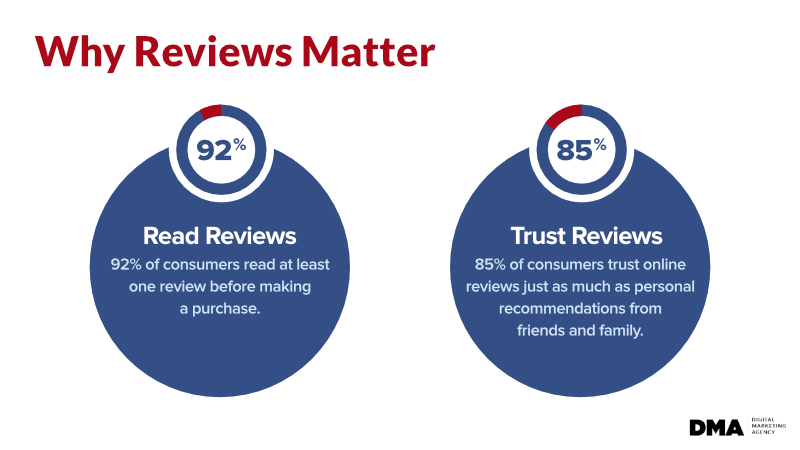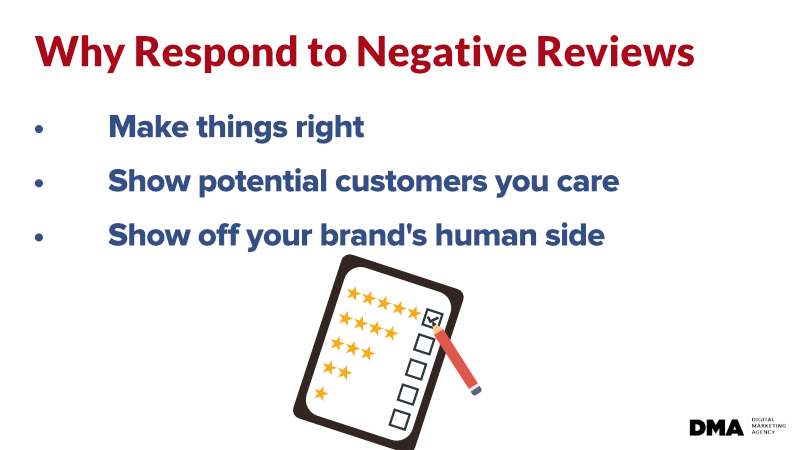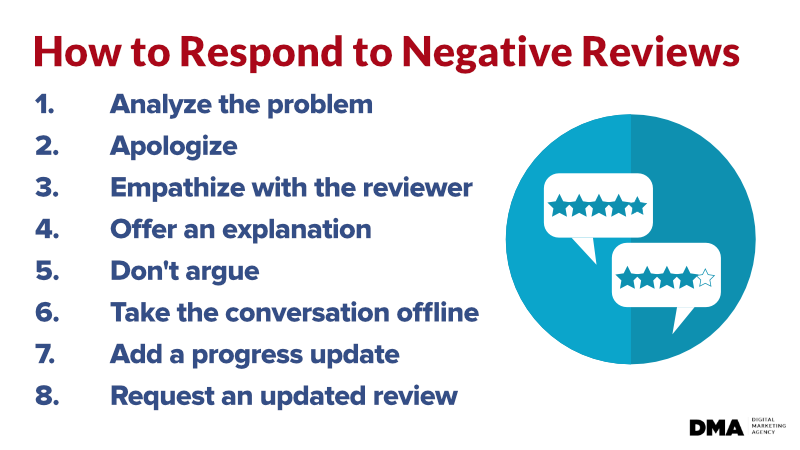SEO
Free SEO Analysis
SEO Services
Content Marketing Services
Local SEO
Link Building Services
Specialized SEO Services
PPC
REPUTATION MANAGEMENT
Free Reputation Management Analysis
Reputation Management Services
Review Management Services
Specialized Reputation Management Services
CEO Reputation Management
Brand Enhancement
Business and Directory Listings
Comprehensive Reputation Management Audit
SOCIAL MEDIA
Free Social Media Analysis
Specialized Social Services
WEB DEVELOPMENT
Free Website Analysis
Web Design Services
Mobile Development Services
Website Maintenance Services
Specialized Development Services
MARKETING AUTOMATION
Free Marketing Automation Analysis
Specialized Marketing Automation Services
Comprehensive Marketing Automation
INDUSTRIES
ABOUT DMA
Reputation Management
Negative Review Response Examples to Improve Your Online Reputation
Request a quote
Its Fast, Easy & Free
Executive Summary
- 92% of consumers read at least one review before making a purchase
- According to Moz, reviews are the third most important ranking factor for Google’s Local Pack.
- Responding to negative reviews gives you a chance to defend your brand against negative attacks.
If you want to keep your online reputation positive, responding to reviews is one of the best things you can do.
In this article, we’ll help you understand why reviews matter to your business and why responding to your negative reviews is vital to your brand’s reputation. Plus, we’ll share a surefire method to respond to negative reviews that will leave the reviewer and others reading your reviews with a good feeling.
We’ll wrap up with negative review response examples you can use to keep customers happy and improve your online reputation.
Why Reviews Matter
Consumers rely heavily on reviews to help them make purchasing decisions. In fact, 92% of consumers read at least one review before making a purchase (Spiegel Research Center, 2017). And 85% of consumers trust online reviews just as much as personal recommendations from friends and family (BrightLocal, 2017).

In other words, you can’t afford to not monitor your reviews.
Reviews also dominate local SEO.
According to Moz, reviews are the third most important ranking factor for Google’s Local Pack. Even outside of local SEO, reviews have a modest impact on rankings.
As if all that weren’t enough, reviews are a great way to get feedback. Yes, even the negative ones. You can use both positive and negative reviews to tweak your offer, improve your service, and make the customer experience better.
Why Respond to Negative Reviews
So, now you know that reviews are important to your brand. But did you know that responding to reviews—particularly negative ones—is also important?

Responding to negative reviews gives you a chance to defend your brand against negative attacks, but there are other, better reasons to respond. Let’s take a look at a few reasons you need to respond to negative reviews.
Make Things Right
Sometimes responding to a negative review is the only chance you’ll have to make things right with an unhappy customer. While many unhappy customers won’t talk to you directly about their problems, they’re likely to leave a review.
You can use the negative review as a chance to get more information about what went wrong so you can make it better and hopefully, keep it from happening again.
Show Potential Customers You Care
How you handle negative reviews shows potential customers what they can expect from doing business with you.
Additionally, having a mix of positive and negative reviews is much more believable than a business that has page after page of nothing but glowing praise.
When you get a negative review, show the unhappy customer and potential customers that you truly value their business and will take steps to make things right.
Show Off Your Brand’s Human Side
As we’ve already hinted, negative reviews can actually make your brand seem more human. A business with nothing but positive reviews may come off as fake or “too good to be true,” but consumers know that negative reviews happen.
How you respond to those negative reviews is what lets consumers know if people want to do business with you.
How to Respond to Negative Reviews
Mistakes happen. Unfortunately, in the business world, those mistakes are typically followed up with negative reviews.
On the bright side, negative reviews present an opportunity for your business to learn something about the way you do business, your customer’s expectations, and how you can better meet those expectations in the future.

Here’s how to respond to negative reviews to create a positive impact on your brand’s reputation.
Step 1. Analyze the Problem
When you first get a negative review, you’ll probably be angry about it. That’s a normal response to negative feedback.
Before you start firing off a reply, though, take the time to really think about what the reviewer is saying.
Always approach the situation from the customer’s point of view. Where did the process break down? Where did you fail to meet their expectations?
Once you have an understanding of the problem you can start your response.
Note: Sometimes you’ll need more information before you can offer assistance. That’s okay, too. If you find that you don’t have enough information to address the problem, you can still reply and ask clarifying questions.
Step 2. Apologize
Start your response with an apology. An unhappy customer wants to feel better and wants to feel seen, so let them know that you care about their experience.
Even if you don’t believe you’re in the wrong, start with an apology.
Step 3. Empathize With the Reviewer
After your apology, it’s time to use that human empathy to relate with your unhappy customer.
If you’ve ever had a negative experience with a business, you know exactly how this customer is feeling. Use that.
Put yourself in your customer’s position and think about how you’d respond in their situation. What would you want to hear from the business?
Approach the situation from the perspective of the customer.
Step 4. Offer an Explanation
You should always be able to tell the customer what happened to create their bad experience.
This does not mean that you’re excusing what happened.
On the contrary, you’ll want to take the time to emphasize your understanding of where the process broke down for the customer and use it as an opportunity to gain a better understanding of how you might be able to keep this scenario from playing out in the future.
Step 5. Don’t Argue
Regardless of what happens, don’t get into an argument with the reviewer.
We know it’s hard. You worked hard to build your business and it’s not comfortable to receive negative feedback.
Stay professional and objective. Acknowledge the reviewer’s feelings and embrace the fact that nobody is perfect.
When you get a negative review, your entire goal should be to reach a solution and get the unhappy customer to leave if not happy, at least satisfied that you treated them fairly.
Remember that you’re never just addressing a single person.
Sure, you’re talking to one person about their negative experience with your business, but you the rest of the people reading the reviews can see how you handle it, too.
When you’re argumentative, you’re letting the reviewer and everyone else reading the reviews that you don’t care about their experience.
Would you want to do business with a company like that?
Invite the unhappy reviewer to discuss the problem out of the review thread. Getting them on the phone or speaking one on one via email will help you get any clarifying information you need and better understand the problem and your business’s role.
Step 6. Take the Conversation Offline
As we mentioned in the previous step, try to get the conversation out of the review thread.
Chances are, you’re not going to solve the problem with your first response. In your first response to the review, give the reviewer options to speak with you to get the complaint resolved.
You don’t have to go into a lot of detail in your response. You can simply say something like:
“I’m so sorry that you’re unhappy! I’d love to address this issue directly to ensure that I fully understand the situation. Can you give me a call at 123-456-7890? If you prefer email, you can reach me directly at name@yourbusiness.com. I look forward to hearing from you and hope we can get this resolved quickly!”
In a simple response like the one above, you’re able to apologize, let the reviewer know you understand that they’re unhappy and that you want to make it better.
That’s all you need to do here.
Step 7. Add a Progress Update
Whether or not the reviewer actually contacts you, you should add a progress update to the review.
If they never reached out to you, your update might be:
“Hi! I haven’t heard from you about this, but I’d still love to help resolve this issue. Please give me a call or shoot me an email when you’re ready!”
This shows others who are reading reviews for your business that you’re taking steps to resolve the problem and are leaving avenues of communication open if the unhappy customer wants to reach out.
This shows other readers that your business’s reputation is important to you and that they can trust your business to make things right should they have a bad experience, too.
If you and the unhappy reviewer are able to reach a satisfactory solution, you can add an update that indicates that.
Again, you don’t have to go into detail. You can keep it very simple like this:
“Thank you so much for speaking with me about this concern. I’m so glad we were able to reach a solution for you and look forward to serving you again in the future!”
This lets other readers know that you’ve taken steps to resolve the reasons for the negative review and inspires confidence.
Step 8. Request an Updated Review
When you’re able to successfully reach a solution that makes the negative reviewer happy, you should ask if they’re willing to update their review.
Many reviewers will be happy to make these updates because you’ve not only removed the reason for their unhappiness, but you’ve left them with a warm feeling about your business.
Negative Review Response Examples to Try
We’ve shared a couple of ways you can respond to negative reviews, but wanted to share some other possible responses with you so you’re fully covered. You can use these as templates and just change the information to match the situation.
Here are more ideas for responding to negative reviews.
Negative Review Response Example #1
Hi [Name]!
I’m [Your Name], and I work as [job title] for [your business]. Thanks so much for taking the time to share your experience. I’m so truly sorry for [your understanding of what happened].
I would love to talk with you directly about this to see what I can do to make this right. Please give me a call at 123-456-7890 or email me at name@yourbusiness.com to chat.
Negative Review Response Example #2: Offering a Discount
Hi [Name]!
I’m [Your Name], and I work as [job title] for [your business]. Thanks so much for taking the time to share your experience. I’m so truly sorry for [your understanding of what happened].
I’d love the chance to make this right with [your offer]. While I know it won’t take the negative experience away, I’m hoping it will make things a little better.
Please give me a call at 123-456-7890 or email me at name@yourbusiness.com to get the [information, codes, etc.] you need to take me up on this.
Negative Review Response Example #3: When You Need More Information
Hi [Name]!
I’m [Your Name], and I work as [job title] for [your business]. Thanks so much for taking the time to share your experience. I’m so truly sorry that you had a bad experience with us.
I’m not quite sure I fully understand the issue and want to make sure that I do everything I can to make this right. Can you give me a call at 123-456-7890 or email me at name@yourbusiness.com so I can get a better understanding of the problem and work on a solution for you?
Negative Review Response Example #4: The Public Update
Hi! I haven’t heard from you about this, but I’d still love to help resolve this issue. Please give me a call or shoot me an email when you’re ready!
Or:
Thank you so much for speaking with me about this concern. I’m so glad we were able to reach a solution for you and look forward to serving you again in the future!
Negative Review Response Example #5: Asking for an Updated Review (Send Directly)
Hi [Name]!
I wanted to follow up with you to make sure that I’ve resolved this issue to your satisfaction.
If I have, great! I would love it if you could update your review to reflect that. Would you be willing to do that for me?
If I haven’t, I really would love to! Please let me know how else I can be of service.
Conclusion
How you respond to negative reviews matters. It matters to the unhappy customer, to the potential customers reading reviews, and it matters to your bottom line.
With the negative review response examples we’ve shared here you can open communication with unhappy customers and hopefully reach a satisfactory solution for all involved.
Of course, negative reviews should be the exception, not the rule. When you only have negative reviews (even with responses and resolutions), that sends a message to potential customers, too.
If you want to get serious about your brand’s reputation, you need the best reputation management service.
Digital Marketing Agency is that service.
We help build and maintain a positive brand reputation through building your online presence across different channels, including press release distributors, web forums, and popular social media websites.
And, we offer review management services, too. Whether it’s Google, Yelp, or Facebook, we can make sure that your online presence is filled to the brim with positivity.
Our Sales team